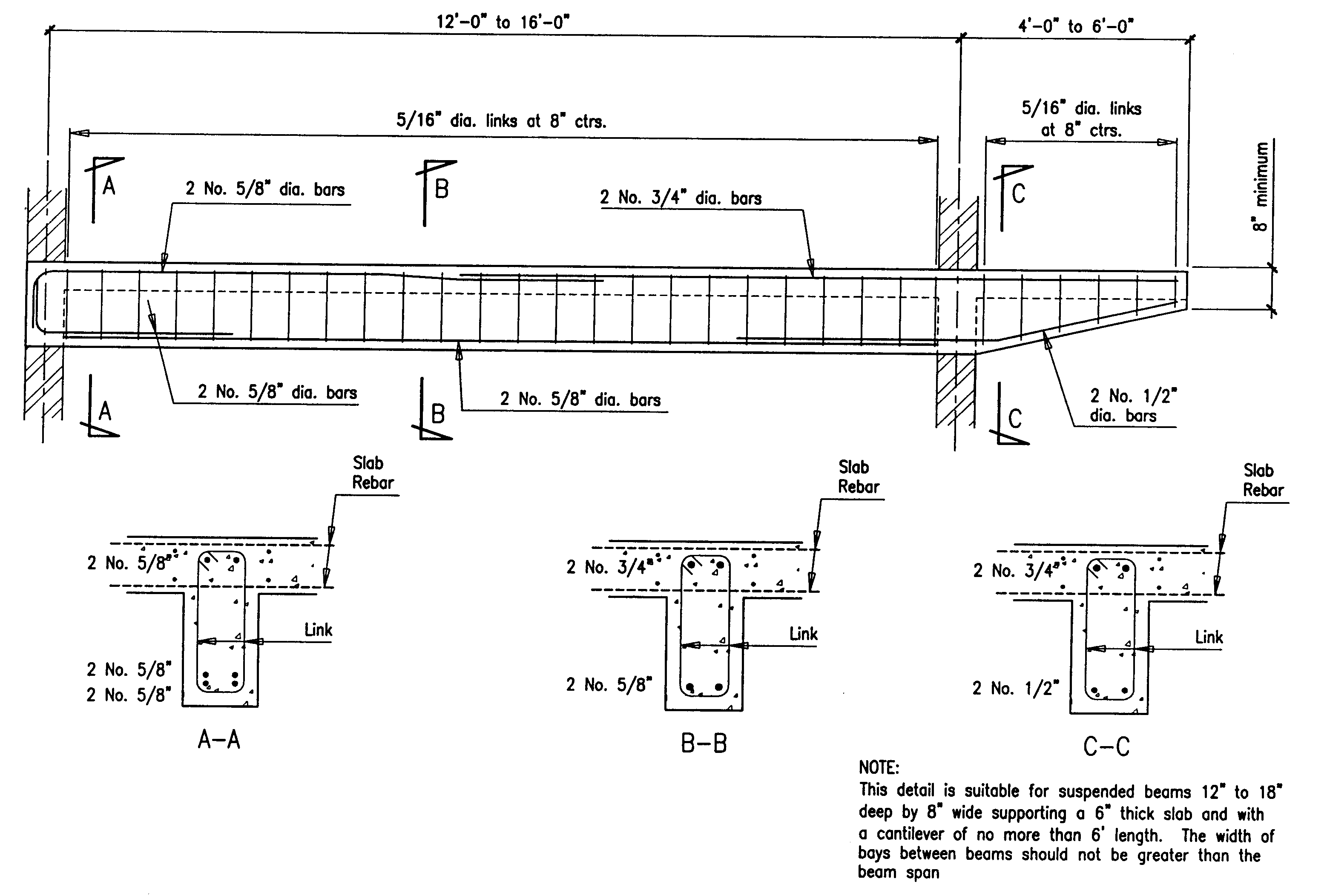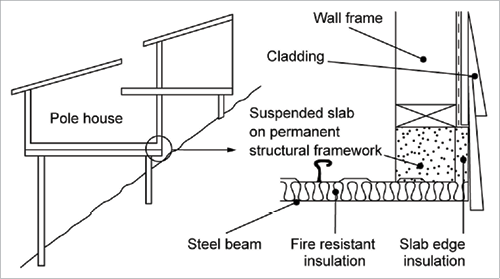Floor Slabs AS 3600 attempts to limit the magnitude of longterm deflection to ensure that floors remain serviceable during the life of any building Code requirements over the past 40 years have become increasingly more stringent, and longterm deflection design is the governing performance criterion for office and similarly loaded floor slabs Good practice for ground floors Ensure all thermal and cold bridging is eliminated around the external perimeter of the floor Ground bearing slabs must have a suitable damp proof membrane which can be placed above or below the insulation Suspended floors should incorporate a ventilated void below the floor with a minimum height of 150 mm Click to see full answer Also to know is, what is a suspended ground floor?

Method Statement For Construction Method Statement Non Suspended Slab
Non suspended floor slab
Non suspended floor slab- A suspended floor is a ground floor with a void underneath the structure The floor can be formed in various ways, using timber joists, precast concrete panels, block and beam system or cast insitu with reinforced concrete However, the floorCauses of foundation or floor slab settlement Broken sewer line, water line, or floor drain under the floor slab Failure to compact the soils properly during construction Trees sapping the ground water under the foundation A plumbing pipe beneath the floor slab of this residence broke Water from the damaged pipe washed away a proportion of




2 2 Structural Element Reinforced Concrete Slabs Ppt Video Online Download
Firstfloor slab thickness The normal thickness used for reinforced concrete slabs in South Africa is 170 mm for small slabs, 255 mm for slabs larger than 5m x 5m and 340 mm thick for longspan slabs forming part of a beam and carrying heavier loads The thickness of a slab will depend on the use and span of the slabA concrete slab is a common structural element of modern buildings, consisting of a flat, horizontal surface made of cast concrete Steelreinforced slabs, typically between 100 and 500 mm thick, are most often used to construct floors and ceilings, while thinner mud slabs may be used for exterior paving In many domestic and industrial buildings, a thick concrete slab supported on foundations or directly on the subsoil, is used to construct the ground floor These slabs Suspended Slab Formwork what is it and applications Suspended slab formwork is formed and cast onsite, and this is done with removable or nonloadable formwork s or permanent formwork s that form part of the reinforcement Therefore, to produce a suspended slab formwork, we need precise formwork, which can be selected from two different types
3 Pour, Compact and Finishing Concrete Floor Slab; Traditional ground floors have consisted of little more than a few flagstones or bricks placed directly over the soil The Victorian era saw the widespread introduction in mass housing with suspended timber floors, alongside rudimentary solid floors in hardwearing areas such as kitchens and hallways This combination persisted well into the 1930s, with solid concreteSuspended floors are normally made up of 2 materials, either timber joists or a concrete beam system There are quite a lot of variations on these types of floor, mainly depending on what use you intend for that floor area and the floor finish In recent years the use of suspended concrete floors has become common
2 V10 • Composite and NonComposite Design Guide wwwascsdcom 11 Panel Features and Benefits Composite deck 3 inch deep, 36 inch coverage, 10 foot to 14 foot Optimal Span Range No Acustadek® Options Proven for 10 to 14 foot span conditionsA floor that is made of timber or other material is not referred to as a floor slab Concrete slabs that form the ground floor of a building may be either supported on beams (called a suspended slab) or supported directly on the subsoil, (via hardcore, for example) called a Suspended Slabs are typically buildup in two ways 1 Precast concrete Unlike onsite concrete pouring, a leading manufacturing approach is used to produce highquality precast concrete in a restrained factory environment The reinforcement is placed in reusable and adjustable molds, and the concrete is poured, vibrated and cured



Non Suspended Slab Is A Slab That Cast On The Ground The Method To Design This Slab Is Different Than Suspended Slab How To Design A Non Suspended Slab Quora




Suspended Floors All You Need To Know Thermohouse
Construction sequence Questions send it to megadethigorot@gmailcom (No need to subscribe or comment if you don't want to ask in public just send a messagFigure 1 shows a ground floor layout plan indicating the locations of ground beams and columns The ground floor is constructed as reinforced concrete nonsuspended slab finished with cement render A B 5000 GB1 (150 x 600) C1 х Х 2400 2 GB2 (150 x 600) 2 GB2 (150 x 600) GB1 (150 x 600) Not to scale Figure 1 Ground floor layout plan a For a 5" thick slab a 6x6W55xW55 mesh will serve For 3 1/2" slab a 6x6W40xW40 will do Anything less is a very bad idea I never spec slabs less than 5" on my projects If the slab is also the finish floor the minimum crack control numbers above are NOT sufficient for a satisfying visual end result




Suspended Slab And Beam Youtube




Building Guidelines Drawings Section B Concrete Construction
The foundation perimeter vertically extends approximately 1/2″1″ above the slab While the perimeter is level, the concrete slab is uneven, hence the 1/2″1″ inch variance The plan is to hang 2×10 joists (using ledger board and joist hangers) 15″ above the foundation perimeter so that the floor will be at the same level as theSlab foundation repair using slab jacking or foam jacking typically costs less than a third the cost of replacement Foam jacking minimizes the cost of flooring repairs because the injection holes are small (dimesize) and relatively infrequent For example, for tiled floors, we can drill holes at the fourway intersections of tiles in the Selection of floor system Actual floor systems in buildings come in all sizes, shapes, and forms There are so many variables to any floor system such as different spans, offset spans, cantilevers, and the extent of continuity, the effects of beams, columns and walls on the slab system, etc that it is difficult to cover all situations in a limited series of charts




2 2 Structural Element Reinforced Concrete Slabs Ppt Video Online Download




Concrete Slab Floors Yourhome
Nonsuspended slabs sit directly on the ground A concrete slab is a common structural element of modern buildings, consisting of a flat, horizontal surface made of cast concrete E2/AS1 gives minimum heights of finished floor levels above ground for concrete slab floors and suspended timber floors, the measurements depending on whetherOnce completed and cured it is put in place by cranes or jacks, then suspension components are attached This includes liftslabSimply, a floor slab functions to distribute without deformation or cracking, the loads applied to it to the weaker subgrade below, in the case of a ground bearing slab, or to the piles supporting it if designed as a suspended ground slab, and to provide a suitable wearing surface upon which the operations in the facility may be carried out efficiently and safely




Building Construction Ii Ecm 3154 Week 1 Floor




Jobsite Conditions John Cox Lumber Co Blog
Suspended concrete slabs are generally constructed in two ways * Precast The slab is constructed in forms elsewhere; Suspended vs Non Suspended TT on Concrete Floor Am considering purchasing a Clearaudio Reference or Master Reference table that would sit on a large Polycrystal amp stand The stand will sit directly on a carpeted concrete slab basement floor The speakers, which are about even w/ the turntable are about 9ft apart (45 from the table)Figure 2 Suspended timber floor with floorboards removed For most heritage properties, the most effective and appropriate way to insulate a suspended floor and improve its airtightness is to retrofit insulation beneath the floorboards, between the supporting joists (figure 2) See our detailed installation guide for more details




How Are Suspended Slabs Built Build




How Are Suspended Slabs Built Quora



0 件のコメント:
コメントを投稿